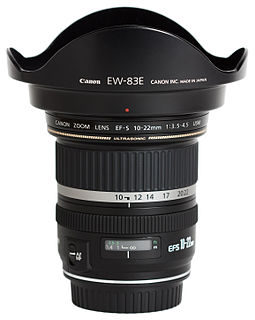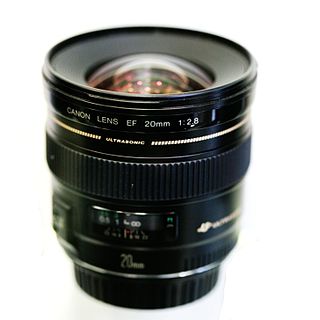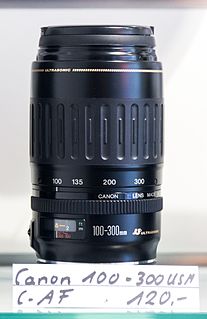
The EF 50mm lenses are a group of normal prime lenses made by Canon that share the same focal length. These lenses are based on the classic double-Gauss lens, with the f/1.8 being a standard six-element double-Gauss with an air gap and powers between element 2 and 3 and its faster cousins adding additional elements. The 50mm focal length, when used with a 35mm film or full-frame sensor, has been widely considered to match the perspective seen by the human eye.
The EF 35 mm lenses are four wide angle prime lenses with EF mount made by Canon Inc. The family also includes one EF-S lens that only mounts on Canon bodies with APS-C sensors. Due to the 1.6 crop factor of Canon APS-C sensors, all of the 35 mm lenses have a 35 mm equivalent focal length of 56 mm, making them normal lenses on APS-C bodies.

The Canon EF 28–70mm f/2.8L is an EF mount wide-to-normal zoom lens made by Canon from 1993 to 2002. It was replaced by the 24–70mm f/2.8L.
The EF 80–200mm lens is a discontinued telephoto zoom lens made by Canon. The lens has an EF lens mount that fits the EOS line of cameras.
The Canon EF 28–105 mm f/4–5.6 is an inexpensive zoom lens often included as a kit lens with Canon 35 mm single-lens reflex cameras. 28–105 mm is a standard wide to telephoto zoom range. The Canon EF 28–105 mm f/3.5–4.5 USM is a higher quality zoom lens with a better build quality. Currently every version of this lens is discontinued. Some versions of the lens may include the word macro or a flower icon which indicates macro capability, however due to the 1:5.2 image magnification ratio it cannot be considered as a true macro lens.

The Canon EF-S 10–22mm f/3.5–4.5 USM lens is a wide to ultra-wide angle zoom lens for Canon digital single-lens reflex cameras with a Canon EF-S lens mount. The field of view has a 35 mm equivalent focal length of 16–35mm, which is analogous to the EF 16–35mm f/2.8L on a full-frame camera. The 10–22mm is an internal focusing lens. Of the 13 elements, one is of Canon's Super Ultra-Low Dispersion glass and three are aspherical elements.
The EF 24–105mm f/4L IS USM is an EF mount wide-to-telephoto zoom lens. It was introduced by Canon in 2005 to complement the well-regarded 17–40mm f/4L USM and 70–200mm f/4L USM.

The Canon EF-S 17–55mm f/2.8 IS USM is a standard zoom lens for Canon digital single-lens reflex cameras with an EF-S lens mount. The field of view has a 35 mm equivalent focal length of 27–88mm.

The EF 500mm lenses are a group of super-telephoto prime lenses made by Canon that share the same focal length.

The Canon EF 20 mm f/2.8 USM lens is an ultra-wide-angle prime lens produced by Canon for the EF lens mount. It features an ultrasonic motor. On a camera with an APS-C sensor the focal length is equivalent to 32 mm, and it is classified as a wide-lens. It features a ring-type USM motor featuring full-time manual and a fixed front element. The optical scheme of the lens includes eleven element in nine groups without any special lens. The performances are considered good, but not enough to compete with modern prime lenses; some zoom lenses from the Canon L series offer similar performances.
Canon Inc. has produced seven different 24mm lenses for its Canon EF and EF-S lens mounts. Three have been discontinued after updated replacements were announced.

The EF 100–300mm refers to three telephoto zoom lenses produced by Canon. They are of the EF lens mount that is compatible with the EOS line of cameras.

The Canon EF-S 18–200mm lens is a superzoom lens, manufactured by Canon. It is the higher end kit lens for the Canon EOS 60D digital camera, and supplants the previous EF-S 17–85mm, in Canon's product line-up, losing 1mm off the wide end, and offering a roughly 2.5x longer telephoto end.
The EF 35-80mm f/4-5.6 USM lens is a family of EF mount wide-to-normal zoom lenses manufactured and sold by Canon. There were five versions made. One contained a peizoelectric motor, three contained a micro motor, and one contained a USM motor.
The EF 35-105mm lens is a family of EF mount wide-to-normal zoom lenses manufactured and sold by Canon. There were three versions made. The first version was released in 1987 as an f/3.5 - f/4.5 aperture lens. The next was released in 1991 as a f/4.5 - f/5.6 aperture lens. The last version was released in 1992 as a f/4.5 - f/5.6 USM version.
The Canon EF 35-135mm f/3.5-4.5 is an EF mount wide-to-normal zoom lens.













